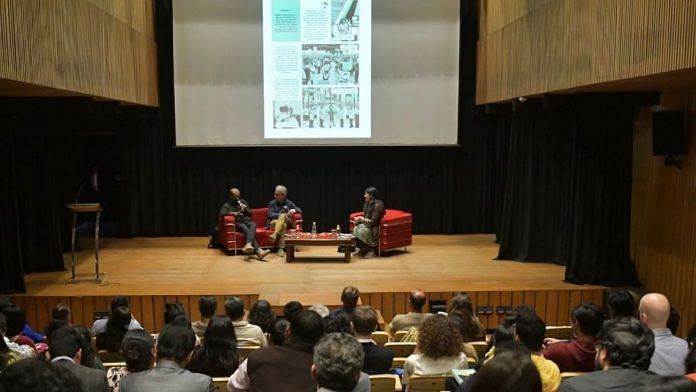New Delhi: When an artist and a physics professor collaborate on a project on artificial intelligence, the result is a fascinating intersection of creativity, morality, and science—in the form of a graphic novel.
“The only way to not be afraid of technology is if you understand it. Our book is an attempt to demystify AI so people won’t be afraid of it anymore,” said graphic artist George Mathen better known by his pen name Appupen at the launch of Dream Machine: AI and the Real World at Delhi’s Alliance Francaise on 1 March. He collaborated with French professor and co-CEO of generative AI company LightOn, Laurent Daudet, to explore the ethical challenges surrounding generative AI’s rise today.
Almost prescient, the book is a sign of its times, conceptualised two months before ChatGPT was officially launched in November 2022. Here, the owner of a ChatGPT-like company is faced with a moral dilemma when a large conglomerate wants to buy his technology. Many of the characters and the challenges they face seem eerily familiar to present-day scenarios, right down to the recent case by Elon Musk against OpenAI, the owner of ChatGPT, for straying from its ideals of an open-source platform.
Through their book, Daudet and Appupen want to cut through the chatter and fear around generative AI.
“AI doesn’t create, it reproduces. I’m not afraid of it stealing my job any time,” said Appupen.
His advice to artists is to view AI as a tool rather than a competitor.
Also Read: 2024 will be the year of AI. Here’s what to expect
The narrative about AI
When Appupen was at an artist residency in France two years ago, he met a scientist who told him that the world “might soon be running out of resources” for AI given the rate at which it is developing. Scary as it was, Appupen was intrigued.
“My friends working in tech back in Bangalore never talk about this side. The story always seems like a positive one to them,” he said.
Daudet and Appupen met shortly after this incident where they agreed to work on a novel on this subject in a way that it would do justice both from the technological and human point of view. The choice to write a novel, not a non-fiction book, was because the storytelling mattered as much as the subject matter.
The authors were also aware that there weren’t many books on AI to begin with let alone any in the form of a graphic novel. Most literature dealing with subjects like generative AI were either science fiction from a few years ago or nonfiction explainers.
“The narrative around artificial intelligence, and especially generative AI applications like ChatGPT or DALL-E remains firmly in the hands of the commercial side of the business,” said Appupen. “How can we get an honest review of AI from the people trying to sell it?”
Also Read: Text-to-video AI the new threat in election season. Here’s something Indian politicians can do
Mirror to real life
The authors wanted to root the book and its characters in as real a world as possible, even using locations like parks and bookstores that they would themselves frequent in Paris.
Real-life events like the NeurIPS—the annual conference on artificial intelligence and machine learning whose tickets “sell faster than concert tickets” according to Daudet—made their way into the graphic novel.
Yet the way real life mirrored the synopsis of the book is something they had not expected. OpenAI’s generative chatbot ChatGPT started to garner public attention in 2022, it was when they were writing the fourth chapter of the book.
“ChatGPT was hardly as popular as it is now, but back then Daudet bet me that this would be it. That out of all other AI applications, ChatGPT would breakthrough and it actually did,” said Appupen with a laugh.
The book’s protagonist is the CEO of an AI company, much like Daudet. His experience added a layer of insight to the narrative of the book and also helped them with the rather unconventional ending they chose.
“We were writing a book about AI at a time when it was all around us. It’s not a futuristic scenario anymore. I thought it would only be fair to also show our readers what it can actually do,” said Appupen,
Also Read: Salman Rushdie to Orwell—banned books just found new life in art
AI as a co-author
After writing their original climax for the book, the authors decided to let AI pitch in with other alternative scenarios. They trained a generative AI application on Appupen’s previous cartoons from the book and provided it with different prompts to draw the climax scene of the novel.
“We aren’t trying to glamourise it, but we do need to show what AI can do truthfully,” said Appupen.
This endeavour, to show readers what AI can do, was also an attempt to apprise them of what it can’t do.
“Once people see this they’ll realise there’s actually nothing intelligent about artificial intelligence. It is just a bunch of stupid statistics,” said Daudet. He suggests that the best way to prevent its misuse is to democratise it, rather than to leave it all in the hands of corporations.
For Appupen, using AI-produced art in his novel didn’t deter him from making his own art and its importance. Artists will continue creating their art despite AI if they love the process itself and not just the finished product.
“Of course, now that I have fed Appupen’s drawings to AI, I don’t need him in the next book,” joked Daudet. Appupen has a quick comeback.
“But who would cut up every image and label it? Your AI isn’t skilled enough for that yet.”
(Edited by Theres Sudeep)



